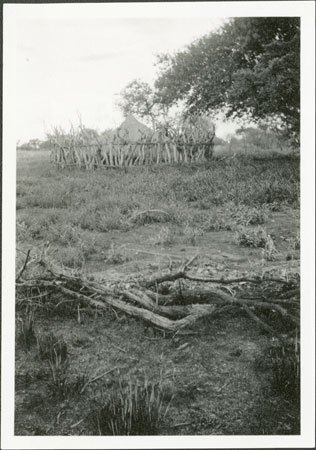Anuak noble's grave

83 x 55 mm | Print gelatin silver
There are records relating to alternative images that we do not have scans for in the database:
1998.342.52.1 - Negative film nitrate , (83 x 55 mm)
1998.342.52.1 - Negative film nitrate , (83 x 55 mm)
Date of Print:
Unknown
Previous PRM Number:
EP.AK.52
Previous Other Number:
05 5 (245)
Accession Number:
1998.342.52.2
Description:
A thatched grave-hut (duat) of a man from a noble lineage (identified as Cam-wa-Medho of the Jowatcuaa clan) surrounded by a fence stockade, located close to the village of Dibango.
Nobles were buried on a platform in a deep shaft, with another platform above and a hut constructed over the top and the entrance sealed.
Finally, a stockade is built around the hut.
Such graves are shown respect when people pass by through removing sandals and other observances.
Photographer:
Edward Evan Evans-Pritchard
Date of Photo:
1935 March - May
Region:
[Southern Sudan] Jonglei Dibango
Group:
Anuak
NamedPerson:
Cam-wa-Medho
PRM Source:
Edward Evan Evans-Pritchard
Acquired:
Donated 1966
Other Owners:
E. E. Evans-Pritchard Collection
Class:
Death , Shelter
Keyword:
Grave , Fence , Building
Primary Documentation:
PRM Accession Records - Accession Book Entry [p.
98] 1966.27 [1 - 24] G[ift] PROFESSOR E.
E.
EVANS-PRITCHARD; INST.
OF SOCIAL ANTHROPOLOGY, 51 BANBURY RD.
OXFORD - 1966.27.19 - S.
SUDAN, DARFUNG.
VARIOUS TRIBES.
Box of negatives in envelopes, [1 - 242] & 1966.27.20 - Box of prints of these negatives [refers to object 1966.27.19] [1 - 242], in envelopes.
Notes on print/mount - "05 5 245 Ugak"
[ NB E-P has crossed out Ugak on the reverse of a number of other prints in favour of Dibango. He may have omitted to do this on this print. Also, the grave is described as being about 100 yards from the Dibango-Ugak path, which may also account for the description][Chris Morton 17/12/2003]
Notes on print/mount - "05 5 245 Ugak"
[ NB E-P has crossed out Ugak on the reverse of a number of other prints in favour of Dibango. He may have omitted to do this on this print. Also, the grave is described as being about 100 yards from the Dibango-Ugak path, which may also account for the description][Chris Morton 17/12/2003]
Other Information:
The grave is identifed as that of Cam-wa-Medho in Plate XIb (facing page 118) of E.
E.
Evans-Pritchard's The Political System of the Anuak of the Anglo-Egyptian Sudan (monographs on Social Anthropology no.4, London School of Economics, 1940).
This is confirmed on page 71 where he states that 'The grave of Cam-wa-Medho (Plate XI) was the only one I saw.
Opposite its entrance are two notched posts (dikweri).
It lies about a hundred yards from the Ugaak-Dibango path and is easily discerned because the bush around it has been burnt...on examining the site I noticed that one of the dikweri posts had a piece of ox's skin attached to it and I was told that this was the skin of an ox that had been slain to feed the men who had watched the grave for several days after burial to protect the body from hyenas".
However, analysis of the genealogy given on page 151 shows that there are three nobles known as Cam-wa-Medho.
It is clear that it is certainly not the noble Cam-wa-Medho of Ajuara village frequently mentioned in that volume, who was in captivity in 1935.
He can be identified in this genealogy as the Cam whose mother is Aboori of the Jowatkanyo clan.
On page 116 E-P also lists another Cam-wa-Medho living at Abetacan who can be identified in the genealogy as the Cam who mother is Ajuai of the Jowatong clan.
This leaves us with the Cam-wa-Medho who mother is Alamo of the Jowatcuaa clan living at Dibango noted also on page 116.
Although in this list he is implied as currently resident there, he is almost certainly the individual whose grave is identified by E-P.
[Chris Morton 19/12/2003]
Recorder:
Christopher Morton 17/12/2003 [Southern Sudan Project]

